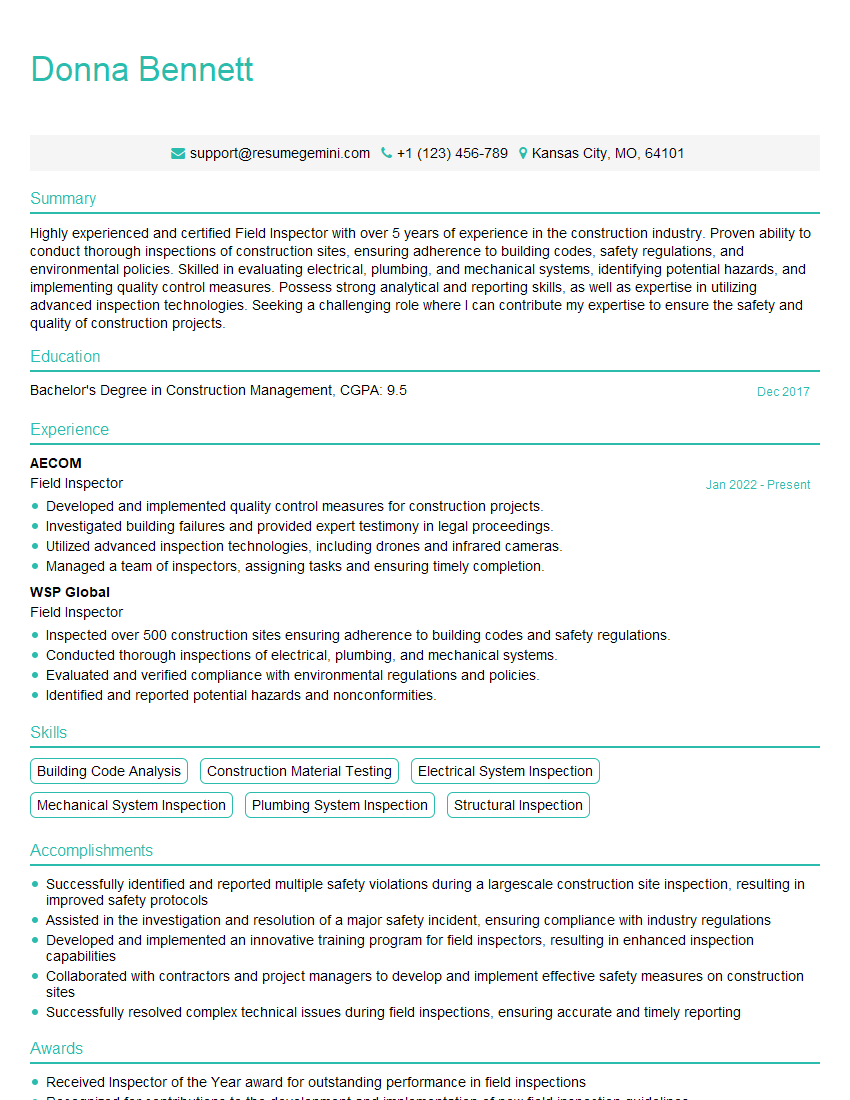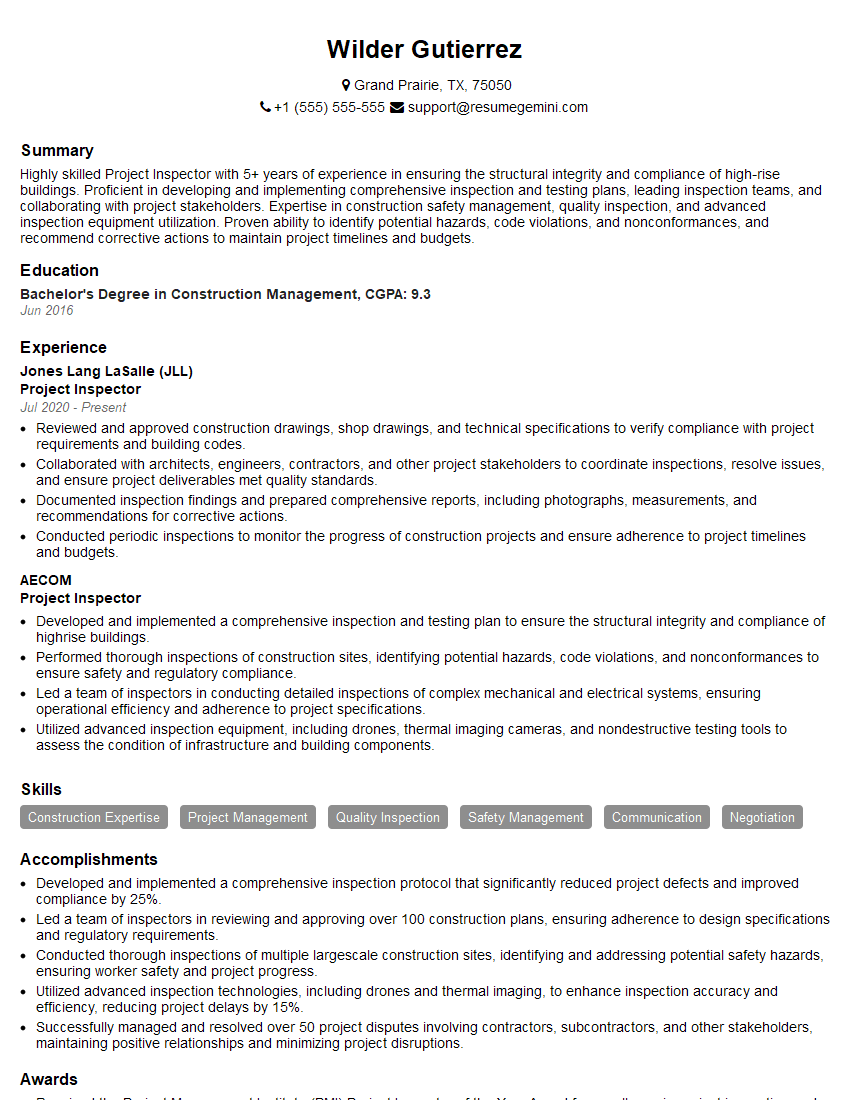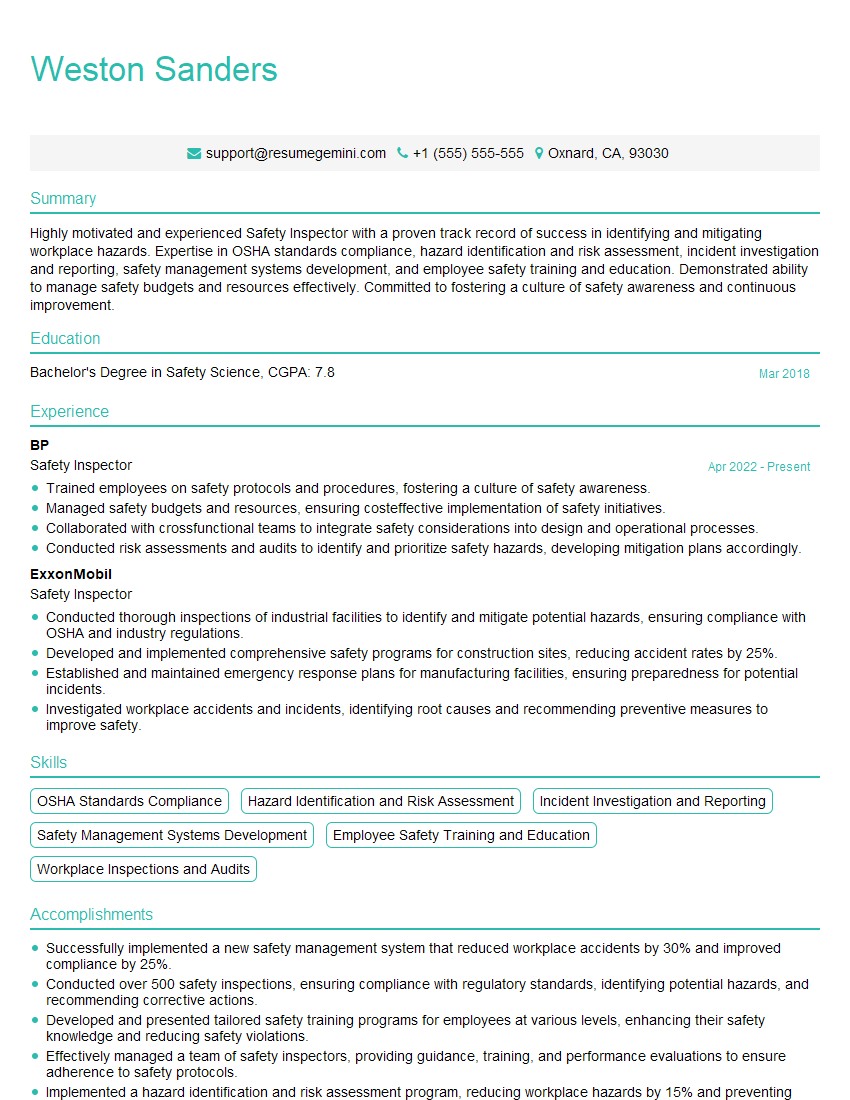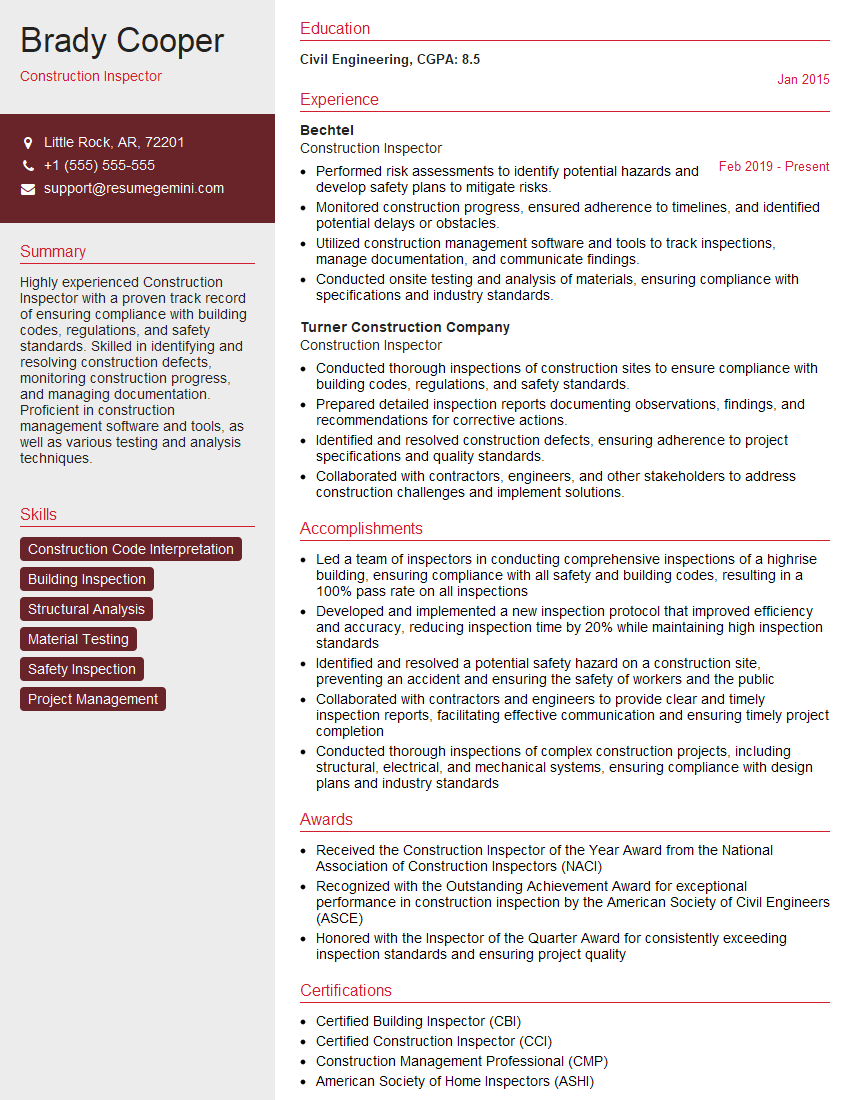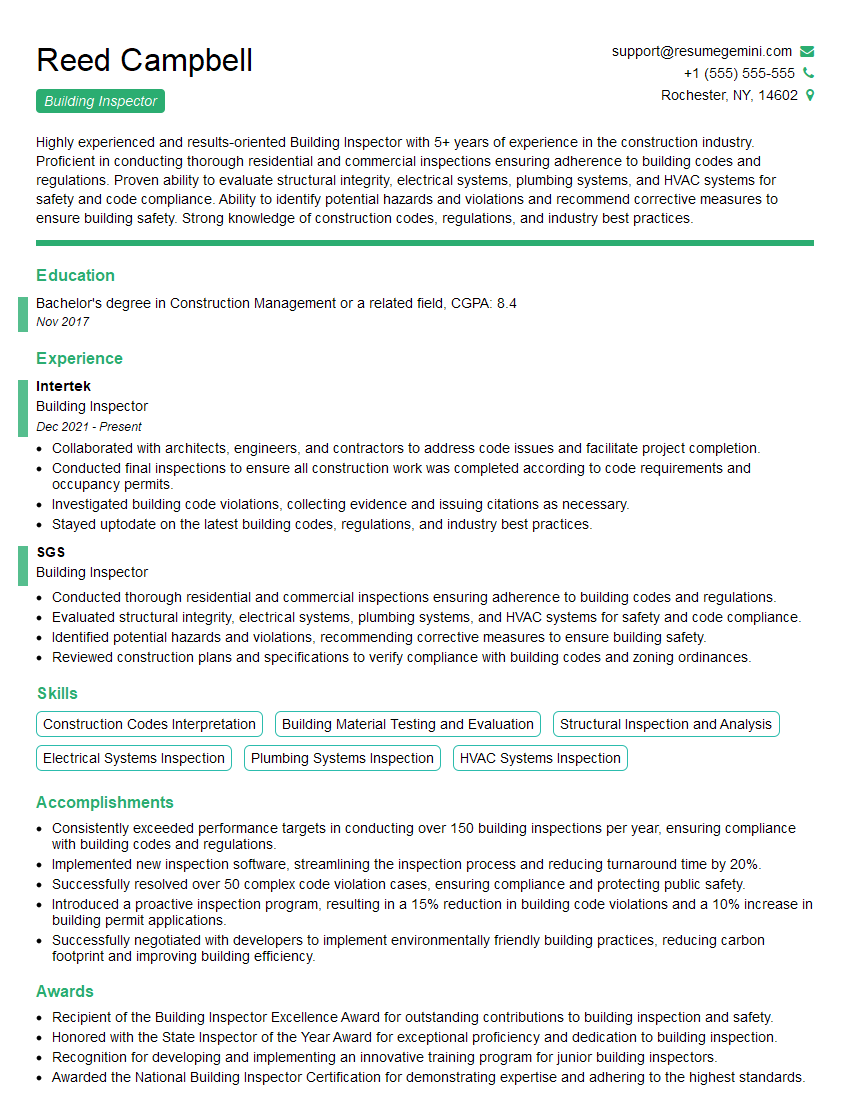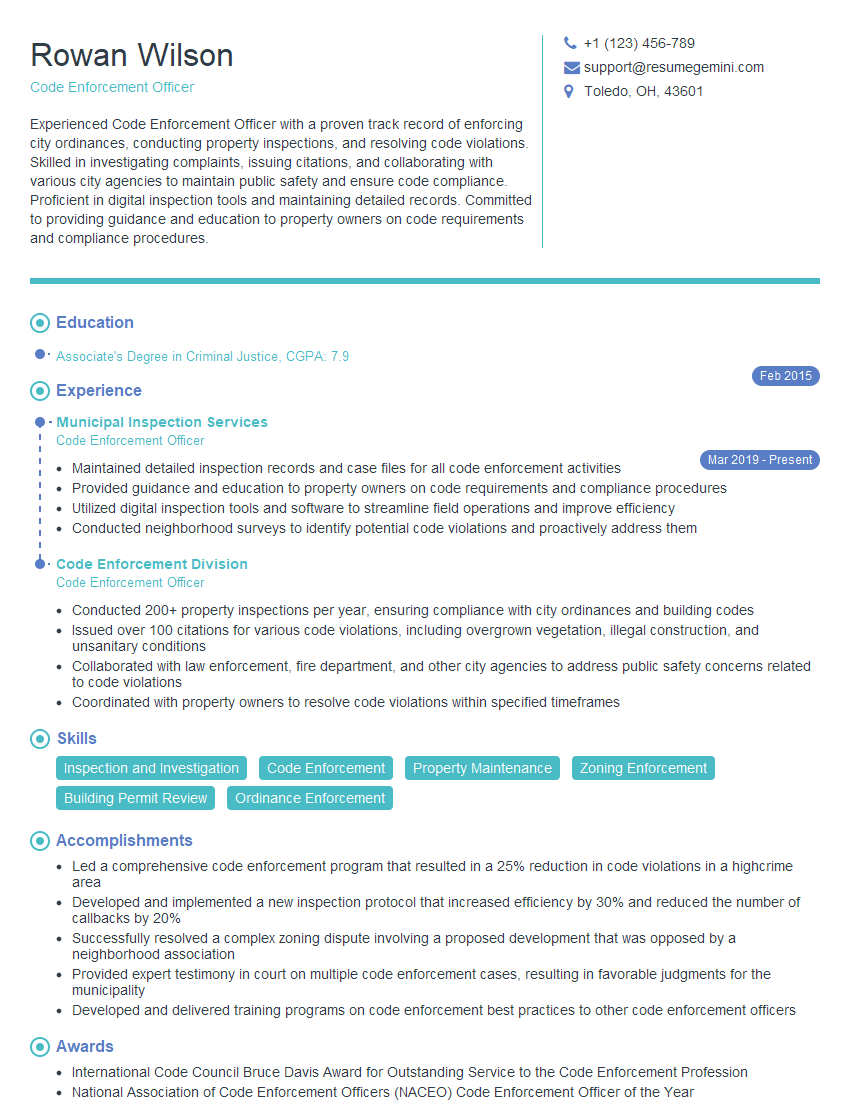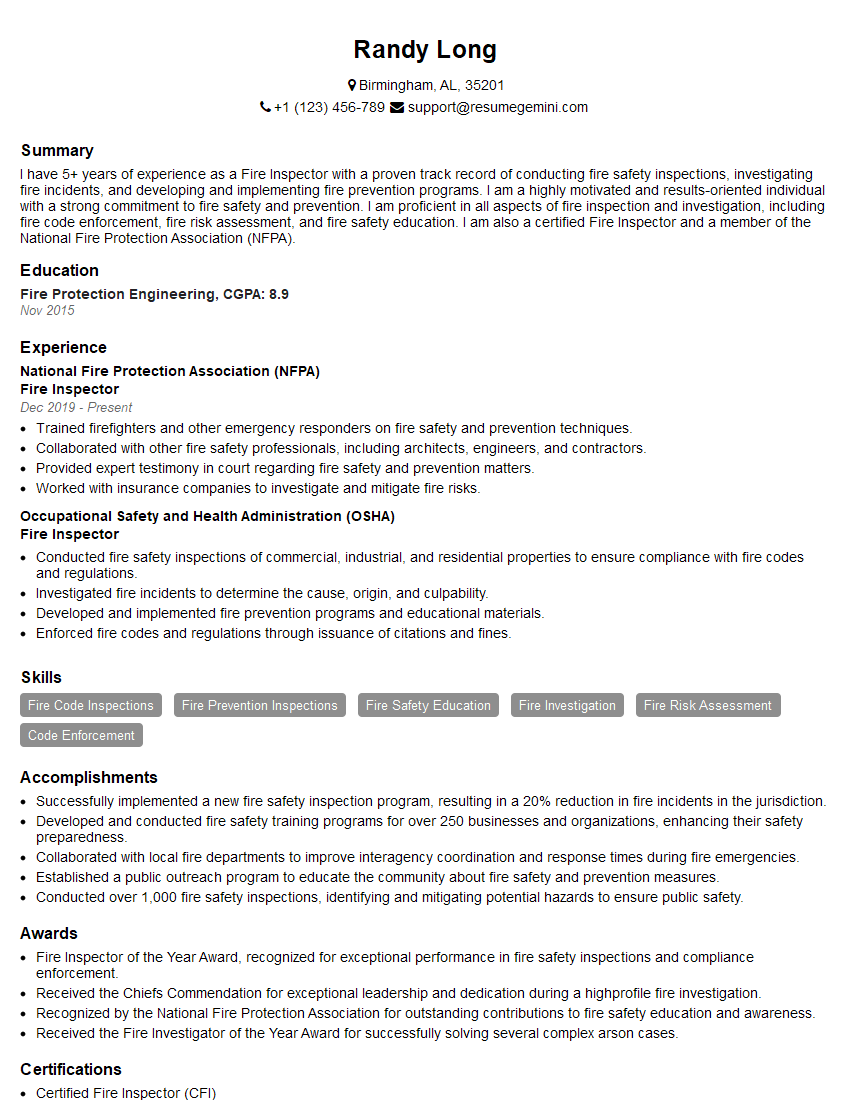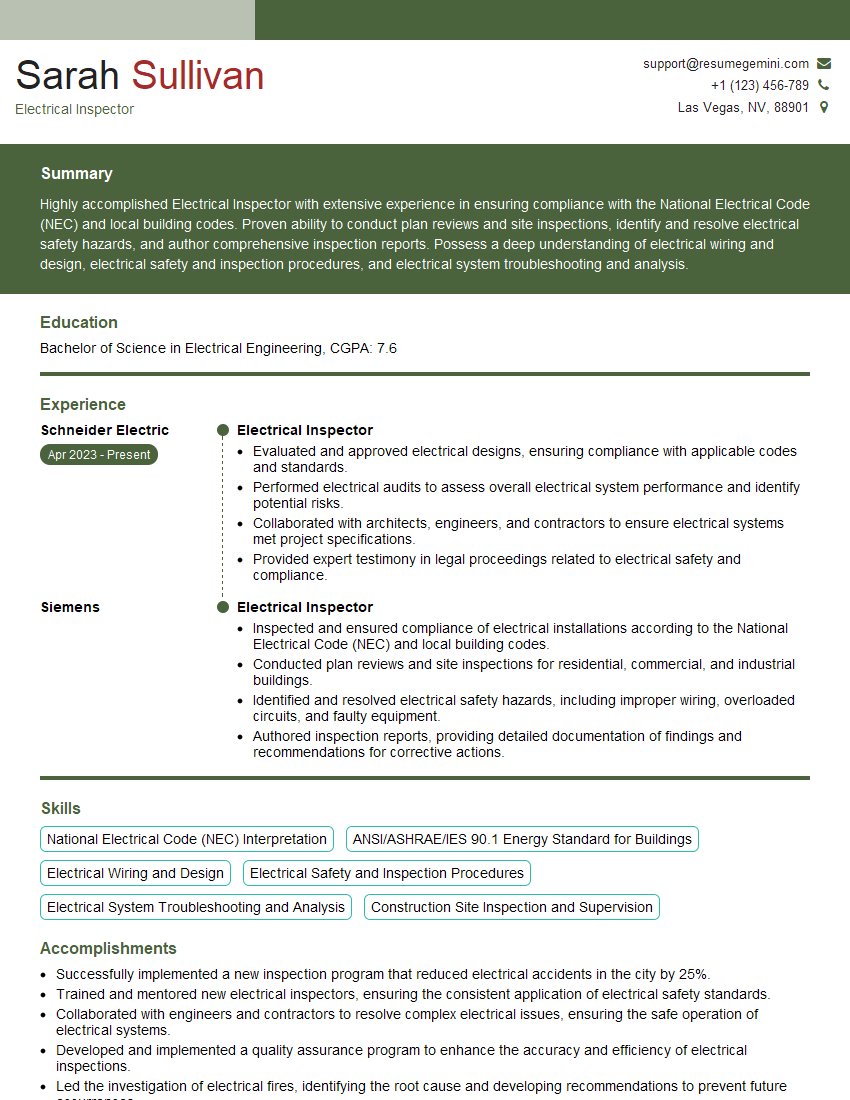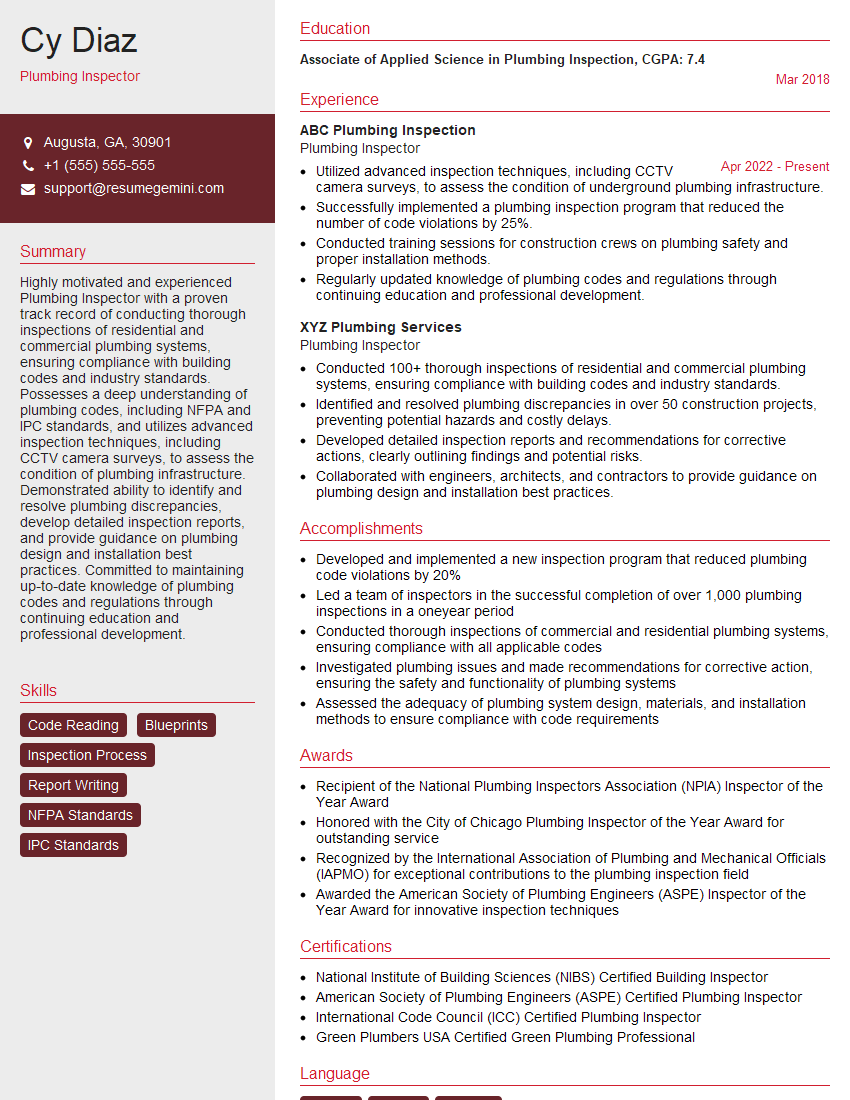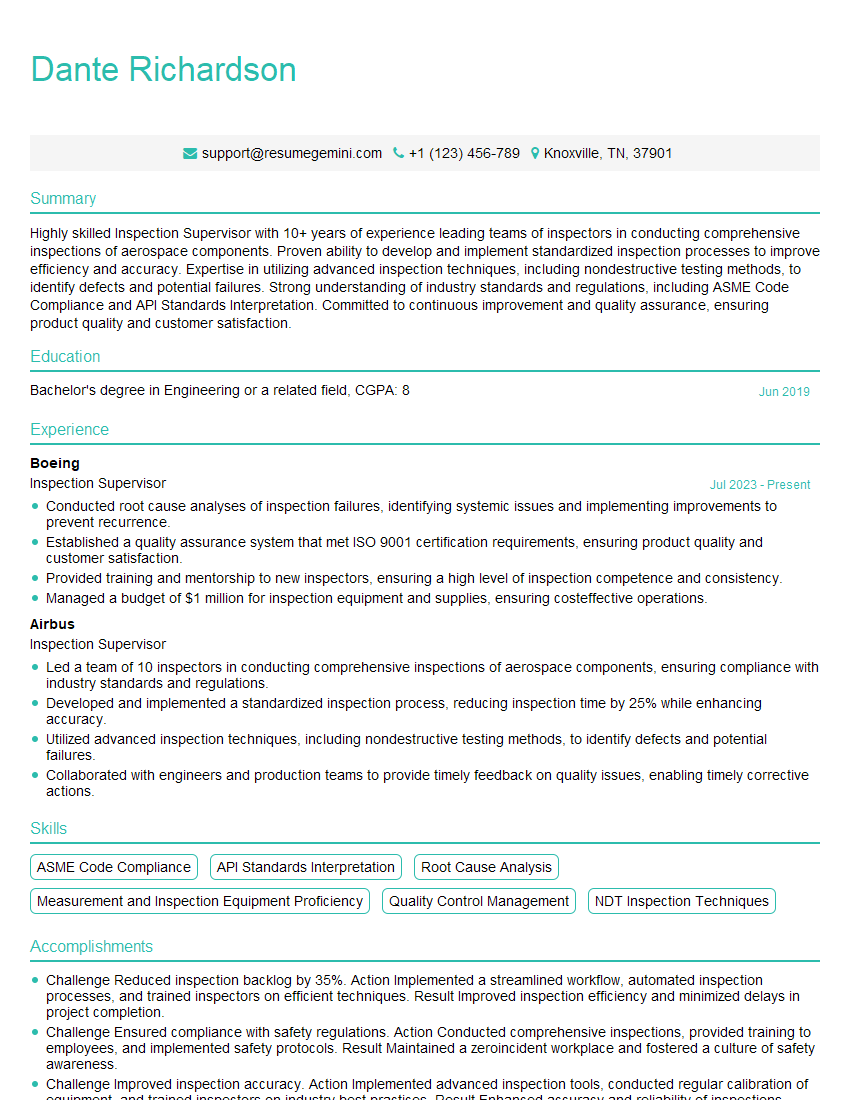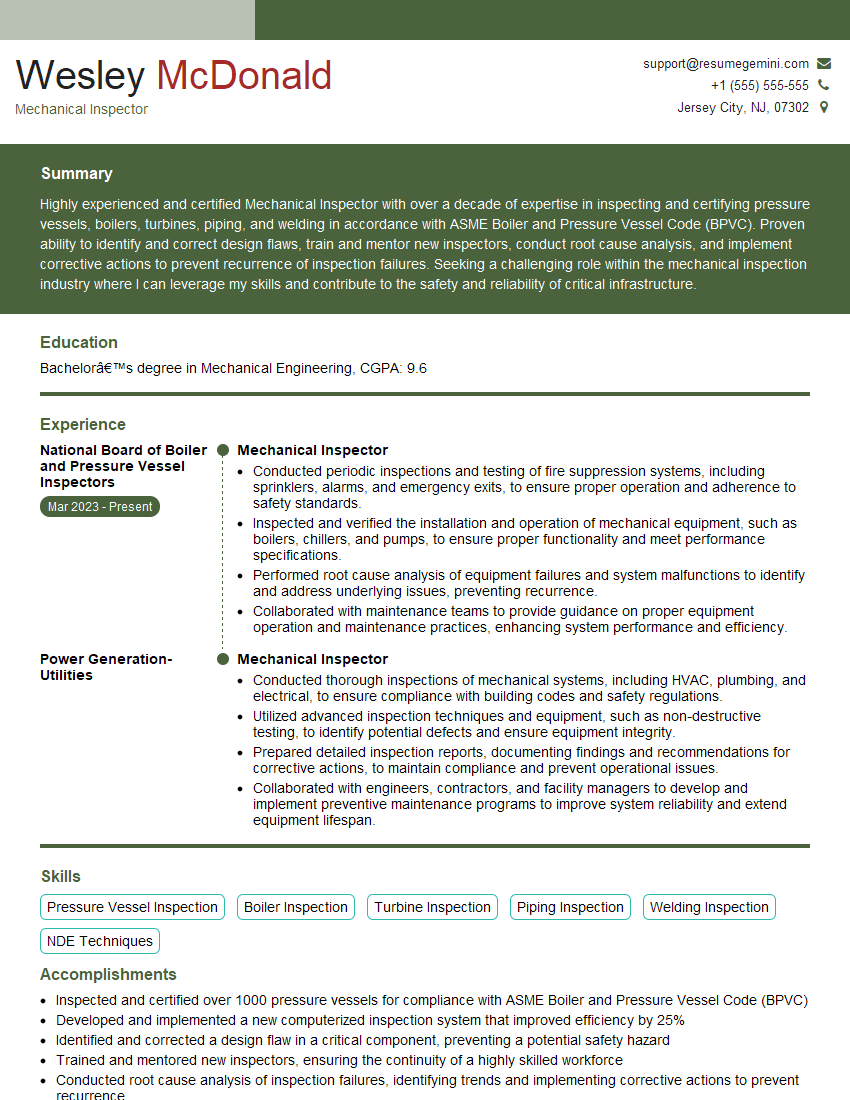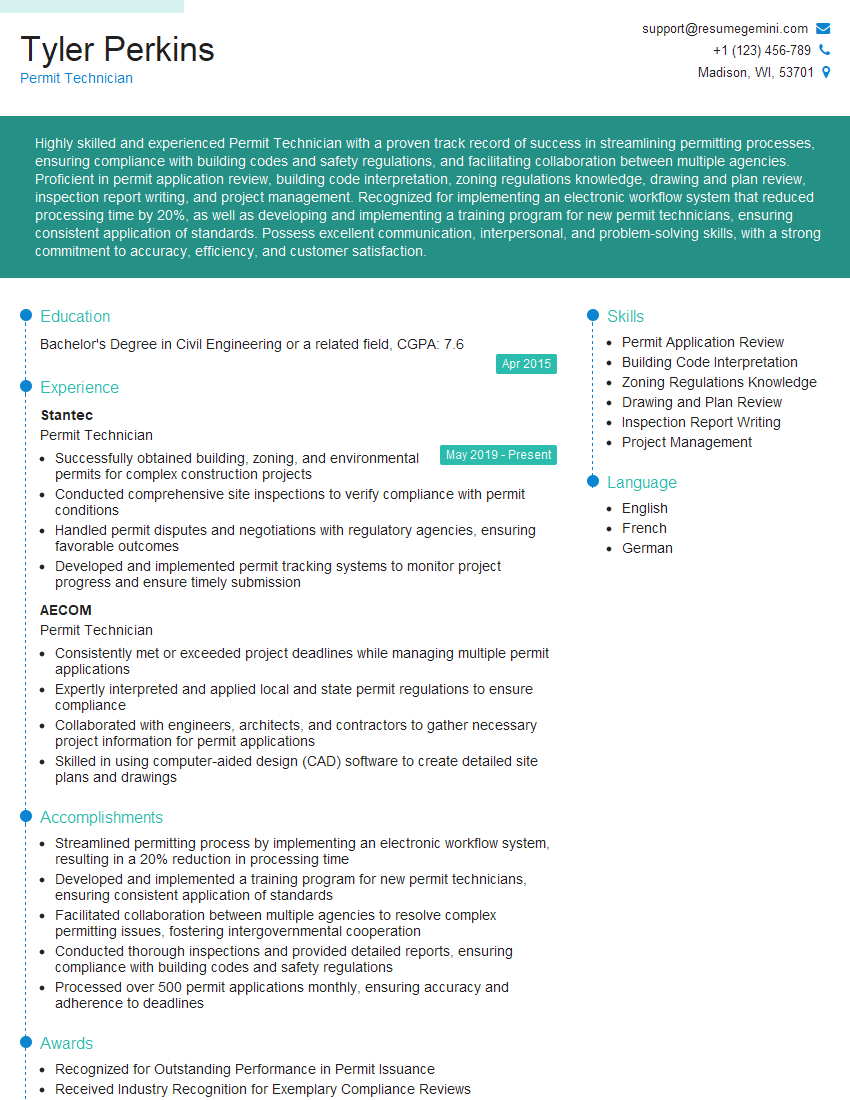Unlock your full potential by mastering the most common Permitting and Inspection interview questions. This blog offers a deep dive into the critical topics, ensuring you’re not only prepared to answer but to excel. With these insights, you’ll approach your interview with clarity and confidence.
Questions Asked in Permitting and Inspection Interview
Q 1. Explain the process of obtaining a building permit.
Obtaining a building permit is a crucial first step in any construction project, ensuring compliance with building codes and safety regulations. The process generally involves several key stages.
- Application Submission: This begins with filling out a detailed application form, providing information about the project, including plans, specifications, and site details. The application often requires signatures from licensed professionals like architects or engineers.
- Plan Review: The permitting authority’s review team then scrutinizes the submitted plans to ensure they meet all applicable building codes (e.g., IBC, NFPA), zoning regulations, and other local ordinances. This can involve checking for structural integrity, fire safety, accessibility, and environmental impact.
- Fee Payment: Once the plans are approved, the applicant pays the necessary permit fees, which vary based on the project’s scope and complexity.
- Permit Issuance: After fee payment and final plan approval, the building permit is issued. This official document grants permission to proceed with construction.
- Ongoing Compliance: It’s crucial to understand that the permit is not just a one-time approval; it necessitates ongoing compliance throughout the construction process, requiring adherence to approved plans and scheduling inspections.
For example, a homeowner renovating their kitchen would submit plans showing the new layout, electrical work, plumbing changes, and any structural modifications. The permitting authority would then review these plans for compliance before issuing the permit.
Q 2. Describe your experience with different building codes (e.g., IBC, NFPA).
My experience encompasses a wide range of building codes, most notably the International Building Code (IBC) and the National Fire Protection Association (NFPA) codes. I’m proficient in interpreting and applying these codes to various project types, from residential renovations to large-scale commercial developments. The IBC provides a comprehensive set of minimum standards for building design, construction, and safety, covering structural, mechanical, plumbing, and electrical systems. The NFPA codes, on the other hand, focus specifically on fire safety, encompassing everything from fire prevention and suppression systems to emergency exits and evacuation plans.
I’ve encountered situations where a seemingly minor detail in the plans, like the spacing of fire sprinklers (NFPA), or the load-bearing capacity of a beam (IBC), could lead to a significant code violation. Understanding the nuances of each code is critical in ensuring projects are safe and compliant. In my experience, thorough knowledge of these codes is vital for effective plan review and inspections.
For instance, I recently worked on a project where the initial design failed to meet the IBC requirements for accessible entrances. Through careful review and collaboration with the architect, we identified the issue and implemented design changes to meet the code, ultimately preventing potential legal and safety concerns.
Q 3. How do you handle permit applications that are incomplete or inaccurate?
Handling incomplete or inaccurate permit applications requires a systematic approach focused on both efficiency and compliance. My strategy involves the following steps:
- Initial Review and Identification: I carefully review the application to identify all missing information or discrepancies.
- Communication with the Applicant: I promptly contact the applicant, clearly explaining the deficiencies and outlining the necessary corrective actions. I provide specific instructions and supporting documentation, such as relevant code sections or guidelines, to aid them in completing the application accurately.
- Documentation and Tracking: I maintain detailed records of all communication and revisions to ensure a transparent and traceable process. This helps me manage multiple incomplete applications concurrently.
- Resubmission and Review: Once the applicant resubmits the corrected application, I conduct a thorough review to ensure the corrections are complete and satisfactory before proceeding with the plan review.
- Rejection (if necessary): In cases where the applicant fails to address the deficiencies adequately, I clearly explain the reasons for rejection and the steps required for resubmission. My aim is always to guide the applicant through the process, not to hinder it needlessly.
One example involved a commercial building permit application missing crucial structural calculations. By clearly explaining the requirements and providing examples, we enabled the applicant to supply the missing documentation and proceed smoothly.
Q 4. What are the key elements of a thorough site inspection?
A thorough site inspection is crucial for ensuring compliance with building codes and the safety of the project. Key elements include:
- Pre-construction Inspection: Verifying the site’s suitability, checking for underground utilities, and confirming that the foundation complies with the approved plans.
- Framing Inspection: Assessing the structural integrity of the framing, ensuring proper connections and compliance with load-bearing requirements.
- Mechanical, Electrical, and Plumbing (MEP) Inspections: Verifying the installation of these systems meets code requirements and safety standards.
- Final Inspection: A comprehensive check of all aspects of the construction, verifying that all work has been completed according to the approved plans and meets all applicable building codes and regulations. This includes the overall safety and functionality of the building.
- Documentation: Detailed photographic and written documentation of observations, including any identified code violations or deficiencies. This documentation serves as a record of compliance, providing a trail for reference and future analysis.
For example, during a framing inspection, I would meticulously check the spacing of wall studs, ensuring they meet the requirements for structural stability and fire resistance. Any discrepancies would be documented, and the contractor would be notified.
Q 5. Explain your experience with various inspection types (e.g., pre-construction, final).
My experience spans various inspection types, each serving a distinct purpose in the construction lifecycle:
- Pre-construction Inspections: These are critical for verifying site suitability, identifying potential issues before construction starts, and ensuring the project starts with a solid foundation (literally and figuratively!).
- Foundation Inspections: These inspections verify that the foundation meets the approved plans and is structurally sound. This helps avoid expensive rework later.
- Framing Inspections: Focus on the structural elements of the building, checking wall framing, roof trusses, and other load-bearing components. It’s crucial for ensuring the building’s structural integrity.
- Rough-in Inspections (MEP): These inspections check the installation of plumbing, electrical, and mechanical systems before they’re covered up. This is a cost-effective way to identify and correct problems early.
- Final Inspections: The final step, confirming everything is complete and compliant, ensuring a safe and functional building ready for occupancy.
I recall one project where a pre-construction inspection revealed an unexpected underground utility line, which potentially saved the contractor from a costly incident. Such proactivity emphasizes the importance of these inspections.
Q 6. How do you identify and document code violations during an inspection?
Identifying and documenting code violations is a critical aspect of my role. I use a systematic approach that combines observation, measurement, and clear communication:
- Observation: During the inspection, I carefully examine all aspects of the construction, comparing the work to the approved plans and applicable building codes. I look for deviations from approved plans and any potential safety hazards.
- Measurement and Verification: I use measuring tools to verify dimensions, clearances, and other critical parameters. For instance, I might check the spacing of electrical outlets or the height of guardrails.
- Documentation: I clearly and concisely document any observed violations, including their location, nature, and severity, using a combination of written reports, photographic evidence, and sometimes even sketches. Specific code sections violated are always referenced.
- Communication: I communicate my findings to the contractor or responsible party, clearly explaining the violations, their potential consequences, and required corrective actions. I provide specific recommendations for remediation.
For instance, if I found insufficient insulation in an exterior wall, I would document the deficiency, including measurements of the existing insulation thickness, a reference to the relevant section of the energy code, and a recommendation for adding the necessary insulation to meet the requirements.
Q 7. Describe your experience using inspection software or databases.
My experience with inspection software and databases is extensive. I’ve used various systems for managing permit applications, scheduling inspections, documenting findings, and generating reports. These systems often streamline the entire inspection process, increasing efficiency and reducing paperwork.
Features I value include:
- Permit Application Tracking: The ability to track the status of permit applications, manage revisions, and communicate efficiently with applicants.
- Inspection Scheduling: Tools for scheduling and managing inspection appointments, sending reminders, and tracking inspector availability.
- Mobile Access: The ability to access and update inspection records in the field using mobile devices, reducing the time required for report generation.
- Reporting and Data Analysis: Generating detailed inspection reports, analyzing data trends, and identifying common code violations to proactively address potential issues in future projects.
One particular software I’ve utilized allows for digital signatures on inspection reports, eliminating the need for paper copies and reducing potential administrative burden. It also integrates directly with our permit database, streamlining the entire process and ensuring data consistency. Such technology has significantly enhanced our inspection workflow efficiency and accuracy.
Q 8. How do you prioritize inspections based on risk and urgency?
Prioritizing inspections involves a risk-based approach, balancing urgency with potential hazards. We use a system that categorizes inspections based on several factors.
- Imminent Danger: Inspections for projects exhibiting clear and present dangers, like exposed wiring or unsupported structures, are prioritized immediately. These often involve stop-work orders until the hazard is mitigated.
- High Risk: Projects involving complex structural elements, hazardous materials (asbestos, lead paint), or critical infrastructure receive high priority. These inspections may occur at key stages of construction, like foundation completion or before occupancy.
- Moderate Risk: Typical residential projects or smaller commercial builds fall into this category. Inspections are scheduled based on the permit timeline and available resources.
- Low Risk: Minor renovations or projects with minimal risk receive the lowest priority.
We utilize a software system that allows us to input these risk factors and automatically generates a prioritized inspection schedule, ensuring efficient resource allocation and mitigating potential safety issues.
Q 9. Explain your approach to resolving conflicts with contractors or developers regarding permits or inspections.
Resolving conflicts requires a collaborative and transparent approach. My strategy involves:
- Open Communication: I start by scheduling a meeting with all parties involved – contractor, developer, and myself – to clearly understand everyone’s perspective and the basis of the disagreement.
- Code Review: We jointly review the relevant building codes and permit requirements, often referencing specific sections and clarifying any ambiguities.
- Mediation: I act as a neutral mediator, guiding the discussion towards a mutually agreeable solution. This might involve clarifying requirements, suggesting alternative approaches that meet code, or even proposing small compromises.
- Documentation: Throughout the process, I meticulously document all discussions, agreements, and decisions. This is crucial should further disputes arise. If a solution can’t be reached, I’ll escalate the issue to a supervisor for further action.
For example, I once mediated a conflict over the type of insulation required. The contractor preferred a cheaper alternative, while the permit specified a higher-rated product. By showing the contractor the specific code section and explaining the safety benefits of the mandated insulation, we reached a solution where the contractor agreed to use the specified material.
Q 10. How do you ensure consistency and fairness in your inspections?
Consistency and fairness are paramount. We achieve this through several methods:
- Standardized Checklists: All inspectors use the same detailed checklists for each type of inspection, ensuring uniformity and covering all code requirements. This minimizes bias and omissions.
- Regular Training: We undergo ongoing training to stay updated on changes in building codes, best practices, and inspection techniques. This ensures that all inspectors are working with the same knowledge base.
- Peer Review: A system of random peer review allows senior inspectors to examine a selection of completed inspections. This process identifies inconsistencies and helps maintain quality standards.
- Transparent Procedures: We ensure our inspection procedures are publicly available and easily accessible. This transparency builds trust and promotes a fair and impartial process.
Our goal is to treat all projects and stakeholders equitably, applying the codes consistently regardless of size, budget or the applicant.
Q 11. Describe your experience with plan review and identifying potential code conflicts.
Plan review is a crucial step in preventing code violations before construction even begins. My approach involves:
- Thorough Review: I meticulously examine the submitted plans, checking for compliance with all applicable building codes, zoning regulations, and safety standards.
- Code Compliance Check: I verify that the proposed design meets all requirements for structural integrity, fire safety, accessibility, and energy efficiency.
- Potential Conflict Identification: I identify potential conflicts early on, such as clashes between different systems (e.g., plumbing and electrical), inadequate clearances, or omissions in the plans. I clearly communicate these to the applicant for correction before any construction commences.
- Software Utilization: I use specialized software to help identify potential clashes and inconsistencies within the plans. This software can detect conflicts automatically, streamlining the review process.
For instance, I once identified a conflict in plans where a proposed ductwork placement would interfere with a critical structural beam. By catching this early, we avoided costly rework during construction. Early identification saves time and resources for all involved.
Q 12. How do you communicate inspection results effectively to stakeholders?
Effective communication of inspection results is vital. We utilize a multi-pronged approach:
- Detailed Reports: We generate comprehensive reports that clearly state the inspection findings, including any violations or areas of non-compliance. We use clear, non-technical language where possible.
- Digital Platforms: Inspection reports and photos are uploaded to a secure online portal that’s accessible to all stakeholders, providing real-time updates.
- Follow-up Communication: We follow up with the applicant to discuss the findings and answer any questions they may have. This fosters collaboration and addresses any concerns promptly.
- Formal Notices: In cases of serious violations, we issue formal notices, clearly outlining the necessary corrective actions and deadlines. These notices are legally compliant and documented.
We prioritize clear and concise communication, ensuring that all stakeholders understand the inspection outcome and the next steps.
Q 13. What is your experience with different types of construction materials and their relevant codes?
My experience encompasses a wide range of construction materials, including:
- Concrete: I am familiar with various concrete mixes, strength requirements, and reinforcement techniques, as outlined in relevant codes like ACI 318.
- Steel: I understand different steel grades, structural design principles, and corrosion protection methods, adhering to standards like AISC.
- Wood: My knowledge includes various wood species, their properties, grading standards, and appropriate treatments for different applications.
- Masonry: I am proficient in identifying different masonry types, their construction techniques, and relevant code requirements for load-bearing and non-load-bearing walls.
- Insulation and Roofing Materials: I have experience inspecting and evaluating various insulation and roofing materials, ensuring they meet energy efficiency and fire safety standards.
For each material, I am adept at verifying its proper installation and compliance with the relevant building codes, ensuring structural integrity and safety.
Q 14. How do you handle complaints regarding permit issuance or inspection procedures?
Handling complaints requires a structured approach that prioritizes fairness and transparency.
- Formal Complaint Process: We have a clear, documented process for handling complaints, ensuring consistent treatment of all issues.
- Thorough Investigation: I conduct a thorough investigation into the complaint, gathering evidence and statements from all involved parties.
- Objective Assessment: I objectively assess the complaint based on relevant codes, regulations, and established procedures, avoiding personal bias.
- Written Response: I provide a written response to the complainant, outlining the findings of the investigation and the actions taken or planned. If a violation occurred, I clearly outline corrective actions.
- Escalation: If the complaint involves serious issues or requires higher-level intervention, I escalate it to my supervisor or relevant authority.
Our goal is to resolve complaints fairly and promptly, ensuring that all concerns are addressed and that the permitting and inspection process remains transparent and accountable.
Q 15. Describe a situation where you had to make a difficult decision during an inspection.
One of the most challenging situations I faced involved a partially completed commercial building. The electrical work, specifically the grounding system, showed significant deviations from the approved plans and the local electrical code. The contractor argued that the deviations were minor and wouldn’t affect safety. However, my experience told me otherwise; insufficient grounding poses a serious fire and electrocution hazard. The decision was difficult because delaying the project would incur substantial financial losses for the contractor, yet approving the work would compromise safety.
My approach involved a three-step process: first, I meticulously documented all deviations with photos and detailed notes. Second, I consulted the local electrical code and referenced specific sections that the work violated. Finally, I presented the contractor with my findings and the safety risks involved, offering specific solutions for remediation. We collaborated on a revised plan, ensuring compliance while minimizing project delays. This situation highlighted the importance of balancing safety regulations with practical project management. The project was ultimately completed to code, and I felt confident I had made the right decision prioritizing safety.
Career Expert Tips:
- Ace those interviews! Prepare effectively by reviewing the Top 50 Most Common Interview Questions on ResumeGemini.
- Navigate your job search with confidence! Explore a wide range of Career Tips on ResumeGemini. Learn about common challenges and recommendations to overcome them.
- Craft the perfect resume! Master the Art of Resume Writing with ResumeGemini’s guide. Showcase your unique qualifications and achievements effectively.
- Don’t miss out on holiday savings! Build your dream resume with ResumeGemini’s ATS optimized templates.
Q 16. How familiar are you with ADA compliance and its impact on inspections?
I am very familiar with the Americans with Disabilities Act (ADA) compliance standards and their critical role in building inspections. ADA compliance ensures accessibility for individuals with disabilities, covering aspects like ramps, elevators, accessible restrooms, signage, and appropriate floor space. During inspections, I meticulously check for compliance with these standards, using the ADA Standards for Accessible Design as my guide. This includes verifying that the building has appropriate access points, sufficient clear floor space for wheelchair maneuvers, accessible routes of travel, and proper signage.
For example, I recently inspected a newly constructed restaurant. I found that the restroom doors were not wide enough to accommodate a wheelchair, and the grab bars in the restroom were not properly positioned. These were significant ADA violations that I documented in my report, necessitating corrections before the business could receive its certificate of occupancy. Non-compliance can result in significant fines and legal issues for the building owner, emphasizing the importance of thorough ADA compliance review during inspections.
Q 17. Explain your understanding of environmental regulations and their relevance to inspections.
Environmental regulations are deeply interwoven with building inspections. My understanding encompasses a wide range of concerns, including water quality, air pollution, hazardous materials handling, and waste disposal. For example, the use of asbestos, lead-based paint, or the proper disposal of construction debris must be carefully scrutinized. These regulations vary by jurisdiction and are designed to protect human health and the environment. I frequently consult resources like the Environmental Protection Agency (EPA) guidelines and state-specific regulations to verify compliance.
In a recent inspection of a renovation project, I discovered that the contractor wasn’t following the proper procedures for asbestos abatement. This was a significant environmental violation, and I immediately halted the work until appropriate remediation and safety measures were in place. The project was restarted only after confirmation of compliance with all applicable environmental regulations. This situation highlighted how thorough understanding of environmental regulations is vital not only for the project but also for protecting the health and safety of workers and the wider community.
Q 18. How do you stay updated on changes in building codes and regulations?
Staying current with building codes and regulations is paramount in my profession. I utilize a multi-pronged approach: First, I subscribe to professional organizations like the International Code Council (ICC), which provide updates on code changes and offer training courses. Second, I actively monitor state and local government websites for amendments or newly enacted regulations. Third, I participate in continuing education programs and workshops focusing on current building practices and relevant code updates.
I also maintain a comprehensive library of relevant codes and standards, both physical and digital, which I frequently review. Being proactive in seeking out updates ensures that I am always applying the most up-to-date and relevant codes to my inspections, guaranteeing consistent adherence to safety and quality standards.
Q 19. How do you ensure the safety of yourself and others during inspections?
Safety is my top priority during every inspection. I always perform a site-specific hazard assessment before commencing. This assessment considers potential risks like falling hazards, electrical hazards, confined spaces, and exposure to hazardous materials. I use appropriate personal protective equipment (PPE), including safety vests, hard hats, safety glasses, and gloves, as needed. Furthermore, I collaborate closely with contractors and site personnel to ensure a safe working environment. This includes establishing clear communication protocols, defining safe zones, and using warning signage where necessary.
For example, when inspecting a high-rise building, I used fall protection equipment and made sure the contractor had the appropriate safety measures in place before I ascended to higher floors. It’s crucial to be aware of the surroundings, communicate effectively, and remain vigilant to minimize the risk of accidents. Safety is not merely a protocol but a fundamental principle guiding every action during my inspections.
Q 20. What is your experience with using surveying equipment or other inspection tools?
I have extensive experience using a variety of surveying equipment and inspection tools. This includes laser distance meters for precise measurements, digital cameras for detailed photographic documentation, moisture meters to detect water damage, and thermal imaging cameras to identify insulation issues or electrical faults. My proficiency extends to utilizing software for analyzing data acquired from these tools, creating comprehensive reports.
For instance, I recently used a laser scanner to create a 3D model of a complex structure. This model helped me identify subtle deviations from the approved plans and aided in the precise documentation of defects. Furthermore, I regularly use specialized apps on tablets and smartphones to streamline the inspection process, improving efficiency and record-keeping. My skillset enables me to collect and analyze data efficiently, ensuring accurate and detailed inspection reports.
Q 21. Describe your experience with preparing inspection reports and documenting findings.
Preparing comprehensive inspection reports and meticulously documenting findings is an integral part of my role. My reports follow a standardized format, including a project overview, a detailed description of the inspection process, a concise summary of findings (both compliant and non-compliant aspects), supporting photographic and other visual evidence, and specific recommendations for remediation. The documentation is structured to be easily understood by both technical and non-technical audiences.
I utilize specialized software to create professional-looking reports, and I maintain a digital archive of all my inspections. Furthermore, I ensure that my reports are clear, concise, and unambiguous, avoiding technical jargon whenever possible to ensure readability and clarity. Accuracy and completeness are paramount, as these reports serve as legal documentation and crucial information for the project stakeholders.
Q 22. How do you manage your workload and deadlines effectively?
Effective workload management is crucial in permitting and inspection. I use a combination of strategies, starting with a robust project management system. This usually involves a digital calendar with color-coded appointments for inspections, permit reviews, and administrative tasks. I prioritize tasks based on deadlines and urgency, often employing a method like Eisenhower Matrix (urgent/important) to categorize my to-dos. For example, a critical permit nearing its expiration date takes precedence over a less time-sensitive permit review. Beyond prioritization, I break down large projects into smaller, manageable tasks to avoid feeling overwhelmed. Regularly reviewing my schedule and adjusting priorities as needed allows me to stay on track and meet deadlines consistently.
Furthermore, I communicate proactively with contractors and applicants to set realistic expectations and manage potential delays. This involves clearly outlining timelines, identifying potential bottlenecks, and maintaining open communication channels for updates and adjustments. Finally, I regularly reflect on my workflow, identifying areas for improvement and adapting my strategies to maximize efficiency. For example, if I consistently find myself running behind on a particular type of inspection, I may explore ways to streamline the process, like developing more efficient checklists or improving communication with stakeholders.
Q 23. How do you handle situations where you disagree with a contractor’s interpretation of building codes?
Disagreements with contractors regarding building code interpretation happen frequently. My approach is always professional and collaborative. First, I review the relevant code sections with the contractor, highlighting the specific points of contention. I explain my interpretation clearly and provide references from the official codebook. I encourage open dialogue and actively listen to the contractor’s perspective. Often, a simple misunderstanding or a different reading of the code is the root cause.
If the disagreement persists, I document everything meticulously. This includes the code sections involved, the contractor’s interpretation, my interpretation, and any relevant evidence or supporting documentation. In some instances, seeking a second opinion from a senior inspector or a code official can help resolve the dispute. Ultimately, the goal is to ensure compliance with the building codes while maintaining a professional relationship with the contractor. If a resolution cannot be found, I follow established procedures for escalating the issue, which could involve issuing a stop-work order or referring the matter to the relevant authority.
Q 24. Explain your experience with different types of inspection reports (e.g., daily, final).
My experience encompasses various inspection reports, each serving a distinct purpose. Daily inspection reports provide a snapshot of the progress made on a construction site on a particular day. They are typically concise, focusing on key observations, potential issues, and any necessary corrective actions. These are essential for tracking progress and addressing problems promptly. Final inspection reports, on the other hand, provide a comprehensive overview of the entire project upon its completion. They confirm that all work complies with the approved plans and building codes. They are more detailed than daily reports, often including photographs, measurements, and a final assessment of compliance.
In addition to these, I’ve also prepared other reports such as pre-construction inspections (to verify site conditions before work begins), intermediate inspections (to monitor progress at various stages of construction), and re-inspection reports (after addressing previously identified deficiencies). The format and content of these reports vary based on the specific requirements of each project and the type of inspection. Regardless of the type, all reports maintain consistent, professional formatting and include clear, concise language to ensure that all findings and conclusions are easily understood by contractors, building owners, and relevant authorities.
Q 25. What steps do you take to ensure the accuracy of your inspection findings?
Ensuring the accuracy of inspection findings is paramount. My approach involves several key steps. First, I always prepare thoroughly before each inspection by reviewing the approved plans, specifications, and relevant building codes. This allows me to identify potential areas of concern beforehand. During the inspection, I use precise measurement tools, and photographic documentation to support my observations. I meticulously document all findings, including any deviations from the approved plans. I use checklists to ensure consistency and avoid overlooking crucial details.
After the inspection, I carefully review my notes and photographic evidence to ensure accuracy and completeness. I cross-reference my findings with the approved plans and building codes to confirm compliance. If there are any ambiguities or uncertainties, I seek clarification from the contractor or other relevant parties before finalizing the report. I maintain a professional, objective attitude throughout the process, avoiding any personal bias that might compromise the accuracy of my findings. This multi-step approach ensures that my inspection findings are accurate, reliable, and defensible.
Q 26. How do you maintain impartiality and avoid conflicts of interest during inspections?
Maintaining impartiality and avoiding conflicts of interest is crucial for my role’s integrity. I adhere strictly to established policies and procedures to ensure objectivity in my inspections. This includes disclosing any potential conflicts of interest, such as personal relationships with contractors or applicants, to my supervisor before undertaking any inspection. I avoid any actions that might be perceived as favoritism or bias, treating all contractors and applicants equally and consistently applying the building codes to all projects.
I refuse any gifts or favors from contractors or applicants, maintaining a professional distance that upholds the trust placed in me by the permitting and inspection authorities. I focus solely on the technical aspects of the inspection and use my knowledge and experience to assess compliance objectively. Moreover, I am committed to ongoing professional development to stay updated on industry best practices and regulations, enhancing my ability to remain impartial and avoid any potential conflict of interest.
Q 27. Describe a time you had to deal with a difficult inspector or contractor.
I once encountered a contractor who consistently disregarded safety regulations on a construction site. Despite repeated warnings and documentation of the violations, the contractor continued with unsafe practices. I tried several approaches: direct communication, showing them the specific code violations, and offering suggestions for remediation. However, the contractor remained uncooperative. I escalated the issue to my supervisor, providing a detailed report with photographic evidence of the safety violations. Ultimately, a stop-work order was issued until the contractor addressed the safety concerns. This experience highlighted the importance of clear communication, meticulous documentation, and the ability to escalate issues through the proper channels when necessary. It also underscored the need for a firm but professional approach to ensure compliance with safety regulations.
Q 28. How do you handle appeals or disputes related to inspection decisions?
Appeals or disputes regarding inspection decisions are handled according to established procedures. When an appeal is lodged, I carefully review the appeal documentation, along with my original inspection report and any supporting evidence. I thoroughly investigate the grounds for the appeal, addressing any points of contention or misinterpretations. If the appeal is deemed valid, I make the necessary corrections or adjustments to my initial decision. However, if the appeal lacks merit, I prepare a detailed response outlining the reasons why the original decision stands.
In cases of significant disagreement, the matter might be escalated to a higher authority within the permitting and inspection department, or even to an external body, depending on the established dispute resolution mechanisms. Throughout the appeal process, I maintain professional communication with the applicant, ensuring that they are kept informed of the progress and the outcome of their appeal. Transparency and clarity are vital in resolving disputes effectively and fairly. The entire process is always well-documented to maintain accountability and protect the integrity of the permitting and inspection system.
Key Topics to Learn for Permitting and Inspection Interview
- Building Code and Regulations: Understanding local, state, and national building codes and regulations, including their practical application in various construction scenarios. This includes familiarity with relevant legal frameworks and potential liabilities.
- Permitting Processes: Detailed knowledge of the permit application process, from initial submission to final approval. This involves understanding the required documentation, review timelines, and potential delays or revisions.
- Inspection Procedures and Techniques: Mastering various inspection methods and techniques for different building components and systems. This includes understanding safety protocols and the use of relevant inspection tools and equipment.
- Plan Review and Interpretation: Ability to accurately interpret construction plans and specifications to ensure compliance with codes and regulations. This includes identifying potential conflicts or discrepancies early on.
- Defect Identification and Reporting: Skills in identifying and documenting construction defects accurately and comprehensively, including generating clear and concise reports. This includes understanding the severity of defects and their potential impact.
- Communication and Collaboration: Effective communication with contractors, developers, and other stakeholders. This includes active listening, problem-solving, and conflict resolution skills.
- Safety Regulations and Procedures: Thorough understanding of occupational safety and health regulations pertaining to construction sites and inspection activities. This includes identifying and mitigating potential hazards.
- Technology in Permitting and Inspection: Familiarity with software and technologies used in the industry, including digital plan review, mobile inspection apps, and data management systems.
- Problem-solving and Decision-Making: Demonstrating the ability to analyze complex situations, identify solutions, and make informed decisions within the context of building codes and safety regulations. This includes navigating ambiguous situations and making sound judgment calls.
Next Steps
Mastering Permitting and Inspection opens doors to a rewarding career with excellent growth potential. It’s a field that is constantly evolving, offering opportunities for specialization and advancement. To stand out, you need a strong resume that showcases your skills and experience effectively. Creating an ATS-friendly resume is crucial to maximizing your chances of getting your application noticed. ResumeGemini is a trusted resource that can help you build a professional and impactful resume. They offer examples of resumes tailored to the Permitting and Inspection field to help guide you. Invest time in crafting a compelling resume – it’s your first impression to potential employers.
Explore more articles
Users Rating of Our Blogs
Share Your Experience
We value your feedback! Please rate our content and share your thoughts (optional).
What Readers Say About Our Blog
Hello,
We found issues with your domain’s email setup that may be sending your messages to spam or blocking them completely. InboxShield Mini shows you how to fix it in minutes — no tech skills required.
Scan your domain now for details: https://inboxshield-mini.com/
— Adam @ InboxShield Mini
Reply STOP to unsubscribe
Hi, are you owner of interviewgemini.com? What if I told you I could help you find extra time in your schedule, reconnect with leads you didn’t even realize you missed, and bring in more “I want to work with you” conversations, without increasing your ad spend or hiring a full-time employee?
All with a flexible, budget-friendly service that could easily pay for itself. Sounds good?
Would it be nice to jump on a quick 10-minute call so I can show you exactly how we make this work?
Best,
Hapei
Marketing Director
Hey, I know you’re the owner of interviewgemini.com. I’ll be quick.
Fundraising for your business is tough and time-consuming. We make it easier by guaranteeing two private investor meetings each month, for six months. No demos, no pitch events – just direct introductions to active investors matched to your startup.
If youR17;re raising, this could help you build real momentum. Want me to send more info?
Hi, I represent an SEO company that specialises in getting you AI citations and higher rankings on Google. I’d like to offer you a 100% free SEO audit for your website. Would you be interested?
Hi, I represent an SEO company that specialises in getting you AI citations and higher rankings on Google. I’d like to offer you a 100% free SEO audit for your website. Would you be interested?
good

